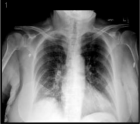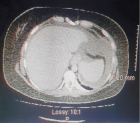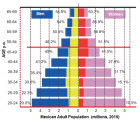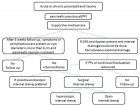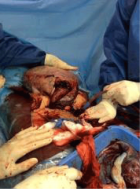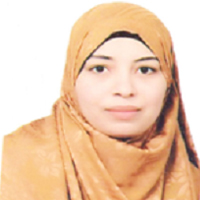Abstract
Research Article
Maximal stability limits in adolescents with Tourette syndrome
Mariève Blanchet*, François Prince, Martin Lemay, Sylvain Chouinard and Julie Messier
Published: 30 January, 2021 | Volume 4 - Issue 1 | Pages: 013-022
We explored if adolescents with Gilles de la Tourette syndrome (GTS) had functional postural control impairments and how these deficits are linked to a disturbance in the processing and integration of sensory information. We evaluated the displacements of the center of pressure (COP) during maximal leaning in four directions (forward, backward, rightward, leftward) and under three sensory conditions (eyes open, eyes closed, eyes closed standing on foam). GTS adolescents showed deficits in postural stability and in lateral postural adjustments but they had similar maximal COP excursion than the control group. The postural performance of the GTS group was poorer in the eyes open condition (time to phase 1 onset, max-mean COP). Moreover, they displayed a poorer ability to maintain the maximum leaning position under the eyes open condition during mediolateral leaning tasks. By contrast, during forward leaning, they showed larger min-max ranges than control subjects while standing on the foam with the eyes closed. Together, these findings support the idea that GTS produces subclinical postural control deficits. Importantly, our results suggest that postural control disorders in GTS are highly sensitive to voluntary postural leaning tasks which have high demand for multimodal sensory integration.
Read Full Article HTML DOI: 10.29328/journal.japch.1001024 Cite this Article Read Full Article PDF
References
- Eddy CM, Cavanna AE, Gulisano M, Calì P, Robertson MM, et al. The effects of comorbid obsessive-compulsive disorder and attention-deficit hyperactivity disorder on quality of life in tourette syndrome. J Neuropsychiatry Clin Neurosci Fall. 2012; 24: 458-462. PubMed: https://pubmed.ncbi.nlm.nih.gov/23224452/
- Hirschtritt ME, Lee PC, Pauls DL, Dion Y, Grados MA, et al. Tourette Syndrome Association International Consortium for Genetics, et al. Lifetime prevalence, age of risk, and genetic relationships of comorbid psychiatric disorders in Tourette syndrome. JAMA Psychiatry 2015; 72: 325-333. PubMed: https://pubmed.ncbi.nlm.nih.gov/25671412/
- Mink JW. Basal ganglia dysfunction in Tourette’s syndrome: A New Hypothesis. Pediatr Neurol. 2001; 25: 190-198. PubMed: https://pubmed.ncbi.nlm.nih.gov/11587872/
- Leckman JF, Bloch MH, Smith ME, Larabi D, Hampson M, et al. Neurobiological substrates of Tourette's disorder. J Child Adolesc Psychopharmacol. 2010; 20: 237-247. PubMed: https://www.ncbi.nlm.nih.gov/pmc/articles/PMC2958453/
- Worbe Y, Malherbe C, Hartmann A, Pélégrini-Issac M, Messé A, et al. Functional immaturity of cortico-basal ganglia networks in Gilles de la Tourette syndrome. Brain. 2012; 135:1937-1946. PubMed: https://pubmed.ncbi.nlm.nih.gov/22434213/
- Patel N, Jankovic J, Hallett M. Sensory aspects of movement disorders. Lancet Neurol. 2014; 13: 100-112. PubMed: https://pubmed.ncbi.nlm.nih.gov/24331796/
- Winter DA, Prince F, Frank JS, Powell C, Zabjek KF, et al. Unified theory regarding A/P and M/L balance in quiet stance. J Neurophysiol. 1996; 75: 2334-2343. PubMed: https://pubmed.ncbi.nlm.nih.gov/8793746/
- Peterka RJ. Sensorimotor integration in human postural control, J Neurophysiol. 2002; 88: 1097-1118. PubMed: https://pubmed.ncbi.nlm.nih.gov/12205132/
- Mancini M, Rocchi L, Horak FB, Chiari L. Effects of Parkinson's disease and levodopa on functional limits of stability. Clin Biomechanics. 2008; 23: 450-458.
- Nagy A, Eördegh G, Paróczy Z, Márkus Z, Benedek G, et al. Multisensory integration in the basal ganglia, European J Neuroscience. 2006; 24: 917–924. PubMed: https://pubmed.ncbi.nlm.nih.gov/16930419/
- Abbruzzese G, Berardelli A. Sensorimotor integration in movement disorders. Mov Disord. 2003; 18: 231-240. PubMed: https://pubmed.ncbi.nlm.nih.gov/12621626/
- Tagliabue M, Ferrigno G, Horak F. Effects of Parkinson's disease on proprioceptive control of posture and reaching while standing. Neuroscience. 2009; 158: 1206-1214. PubMed: https://pubmed.ncbi.nlm.nih.gov/19136043/
- Blanchet M, Prince F, Chouinard S, Messier J, et al. Postural stability limits in manifest and premanifest Huntington’s disease under different sensory conditions. Neuroscience. 2014; 279: 102-112. PubMed: https://pubmed.ncbi.nlm.nih.gov/25168735/
- Tian JR, Herdman SJ, Zee DS, Folstein SE, et al. Postural control in Huntington's disease, Acta Oto-Laryngologica. Supplementum. 1991; 481: 333-336. PubMed: https://pubmed.ncbi.nlm.nih.gov/1833947/
- Visser JE, Bloem BR. Role of the basal ganglia in balance control. Neural Plasticity. 2005; 12: 161-174. PubMed: https://pubmed.ncbi.nlm.nih.gov/16097484/
- Konczak J, Corcos DM, Horak F, Poizner H, Shapiro M, et al. Proprioception and motor control in Parkinson's disease. J Motor Behavior. 2009; 41: 543-552. PubMed: https://pubmed.ncbi.nlm.nih.gov/19592360/
- Schultz RT, Carter AS, Gladstone M, Scahill L, Leckman JF, et al. Visual-motor integration functioning in children with Tourette syndrome. Neuropsychology. 1998; 12: 134-145. PubMed: https://pubmed.ncbi.nlm.nih.gov/9460741/
- Berardelli A, Currà A, Fabbrini G, Gilio F, Manfredi M, et al. Pathophysiology of tics and Tourette syndrome. J Neurol. 2003; 250: 781–787. PubMed: https://pubmed.ncbi.nlm.nih.gov/12883917/
- Biermann-Ruben K, Miller A, Franzkowiak S, Finis J, Pollok B, et al. Increased sensory feedback in Tourette syndrome. NeuroImage. 2012; 63: 119-125. PubMed: https://pubmed.ncbi.nlm.nih.gov/22776453/
- Georgiou N, Bradshaw JL, Phillips JG, Bradshaw JA, Chiu E, et al. Advance information and movement sequencing in Gilles de la Tourette's syndrome. J Neurol Neurosurg Psychiatry. 1995; 58: 184-191. PubMed: https://www.ncbi.nlm.nih.gov/pmc/articles/PMC1073315/
- Neuner I, Arrubla J, Ehlen C, Janouschek H, Nordt C, et al. Fine motor skills in adult Tourette patients are task-dependent, BMC Neurol. 2012; 11: 120-128. PubMed: https://pubmed.ncbi.nlm.nih.gov/23057645/
- Lemay M, Termoz N, Lesperance P, Chouinard S, Rouleau GA, et al. Postural control anomalies in children with Tourette syndrome, Experimental Brain Res. 2007; 179: 525-530. PubMed: https://pubmed.ncbi.nlm.nih.gov/17342479/
- Liu WY, Ya-Ting H, Lien HY, Wang HS, Wong AM, et al. Deficits in sensory organization for postural stability in children with Tourette syndrome. Clin Neurol Neurosurg. 2015; 129: S36-40. PubMed: https://pubmed.ncbi.nlm.nih.gov/25683311/
- Assaiante C. Action and representation of action during childhood and adolescence: A functional approach. Neurophysiologie Clinique/Clinical Neurophysiology. 2011; 42: 43-51. PubMed: https://pubmed.ncbi.nlm.nih.gov/22200341/
- Weisman H, Parush S, Apter A, Fennig S, Benaroya-Milshtein N, et al. A study of sensory dysregulation in children with tic disorders. J Neural Transm. 2018; 125: 1077-1085. PubMed: https://pubmed.ncbi.nlm.nih.gov/29473112/
- Ismail FY, Fatemi A, Johnston MV. Cerebral plasticity: windows of opportunity in the developing brain. Eur J Paediatr Neurol. 2017; 21: 23-48. PubMed: https://pubmed.ncbi.nlm.nih.gov/27567276/
- Blanchet M, Prince F, Messier J. Development of postural stability limits: anteroposterior and mediolateral postural adjustment mechanisms do not follow the same maturation process, Human Movement Sci. 2019; 63: 164–171. PubMed: https://pubmed.ncbi.nlm.nih.gov/25168735/
- Definitions and classification of tic disorders. The Tourette Syndrome Classification Study Group, Archives of neurology. 1993; 50: 1013–1016. PubMed: https://pubmed.ncbi.nlm.nih.gov/8215958/
- Goodman WK, Price LH, Rasmussen SA, Mazure C, Fleischmann RL, et al. The yale-brown obsessive-compulsive scale. I. Development, use, and reliability. Arch General Psychiatry. 1989; 46: 1006–1011. PubMed: https://pubmed.ncbi.nlm.nih.gov/2684084/
- Wu G, Chiang JH. The effects of surface compliance on foot pressure in stance. Gait & Posture. 1996; 4: 122-129.
- Riach CL, Starkes JL. Velocity of center of pressure excursions as an indicator of postural control systems in children. Gait & Posture. 1994; 2: 167-72.
- Van Wegen EEH, Van Emmerik REA, Riccio GE, et al. Postural orientation: age-related changes in variability and time-to-boundary. Hum Mov Sci. 2002; 21: 61-84. PubMed: https://pubmed.ncbi.nlm.nih.gov/11983434/
- Newton RA. Validity of the multi-directional reach test: a practical measure for limits of stability in older adults. J Gerontol A Biol Sci Med Sci. 2001; 56: 248-52. PubMed: https://pubmed.ncbi.nlm.nih.gov/11283199/
- Horak FB, Macpherson JM. Balance orientation and equilibrium, (Section 12, Chapter 7). in: J. Shepard, L. Rowell (Eds.), Handbook of physiology. Exercise: Regulation and Integration of Multiple Systems, Oxford University Press. NY. 1996; 255–292.
- Cox JH, Seri S, Cavanna AE. Sensory aspects of Tourette syndrome, Neurosci Biobehav Rev. 2018; 88: 170-176. PubMed: https://pubmed.ncbi.nlm.nih.gov/29559228/
- Sutherland Owens AN, Miguel EC, Swerdlow NR. Sensory Gating Scales and Premonitory Urges in Tourette Syndrome. Scientific World J. 2011; 22: 736–741. PubMed: https://pubmed.ncbi.nlm.nih.gov/21442151/
- Jacobs JV, Horak FB. Abnormal proprioceptive-motor integration contributes to hypometric postural responses of subjects with Parkinson's disease. Neuroscience. 2006; 141: 999-1009. PubMed: https://pubmed.ncbi.nlm.nih.gov/16713110/
- Orth M, Münchau A. Transcranial magnetic stimulation studies of sensorimotor networks in Tourette syndrome. Behav Neurol. 2013; 27: 57-64. PubMed: https://pubmed.ncbi.nlm.nih.gov/23187144/
- Desmurget M, Gaveau V, Vindras P, Turner RS, Broussolle E, et al. On-line motor control in patients with Parkinson's disease. Brain. 2004; 127: 1755-1773.
- Adamovich SV, Berkinblit MB, Hening W, Sage J, Poizner H. The interaction of visual and proprioceptive inputs in pointing to actual and remembered targets in Parkinson's disease. Neuroscience. 2001; 104: 1027-1041. PubMed: https://pubmed.ncbi.nlm.nih.gov/11457588/
- Kirshenbaum N, Riach CL, Starkes JL. Non-linear development of postural control and strategy use in young children: a longitudinal study. Experimental Brain Res. 2001; 40: 420-431. PubMed: https://pubmed.ncbi.nlm.nih.gov/11685395/
- Farhim CF, Yoon U, Das S, Lyttelton O, Chen J. Somatosensory–motor bodily representation cortical thinning in Tourette: Effects of tic severity. Age and Gender. Cortex. 2010; 46: 750-760.
- Hong KE, Ock SM, Kang MH, Kim CE, Bae JN, et al. The segmented regional volumes of the cerebrum and cerebellum in boys with Tourette syndrome. J Korean Med Sci. 2002; 17: 530-536. PubMed: https://www.ncbi.nlm.nih.gov/pmc/articles/PMC3054894/
- Miller AM, Bansal R, Hao X, Sanchez-Pena JP, Sobel LJ, et al. Enlargement of Thalamic Nuclei in Tourette Syndrome. Arc General Psychiatry. 2010; 67: 955-964. PubMed: https://pubmed.ncbi.nlm.nih.gov/20819989/
- Peterson BS. Neuroimaging studies of Tourette syndrome: a decade of progress. Advances Neurol. 2001; 85: 179-196. PubMed: https://pubmed.ncbi.nlm.nih.gov/11530427/
- Sowell ER, Kan E, Yoshii J, Thompson PM, Bansal R, et al. Thinning of sensorimotor cortices in children with Tourette syndrome. Nat Neurosci. 2008; 11: 637-639. PubMed: https://pubmed.ncbi.nlm.nih.gov/18488025/
- Franzkowiak S, Pollok B, Biermann-Ruben K, Südmeyer M, Paszek J, et al. Motor-Cortical Interaction in Gilles de la Tourette Syndrome. PLoS One. 2012; 7: e27850. PubMed: https://pubmed.ncbi.nlm.nih.gov/22238571/
- Cohen AJ, Leckman JF. Sensory phenomena associated with Gilles de la Tourette’s syndrome. J Clin Psychiatry. 1992; 53: 319–323. PubMed: https://pubmed.ncbi.nlm.nih.gov/1517194/
- Evers RA, van de Wetering BJ. A treatment model for motor tics based on a specific tension-reduction technique. J Behav Ther Exp Psychiatry. 1994; 25: 255-260. PubMed: https://pubmed.ncbi.nlm.nih.gov/7852608/
- Szejko N, Jakubczyk A, Dunalska A, Janik P. Dystonic tics in patients with Gilles de la Tourette syndrome. Neurol Neurochir Pol. 2019; 53: 335-340. PubMed: https://pubmed.ncbi.nlm.nih.gov/31621889/
Figures:

Figure 1
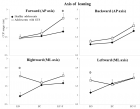
Figure 2

Figure 3
Similar Articles
-
Congenital poisoning after maternal parenteral mercury administrationBenjamin Courchia*,Leventer Roberts Maya,Meyer John,Galvez Maida,Herrera Jaime,Rauch Daniel. Congenital poisoning after maternal parenteral mercury administration. . 2018 doi: 10.29328/journal.japch.1001001; 1: 001-005
-
The Impact of Adenotonsillectomy on Health-Related Quality of Life in Paediatric PatientsShuaib Kayode Aremu*. The Impact of Adenotonsillectomy on Health-Related Quality of Life in Paediatric Patients. . 2018 doi: 10.29328/journal.japch.1001002; 1: 006-011
-
Severe Infantile Transaldolase deficiency: A case reportKhaled Alqoaer*,Ziad Asaad,Maisa Halabi. Severe Infantile Transaldolase deficiency: A case report. . 2019 doi: 10.29328/journal.japch.1001003; 2: 001-003
-
Prevalence of ESBL urinary tract infection in childrenKhalil Salameh*,Galia ZA Awean,Hala Elmohamed,Hoor Alshmayt,Mohamed Riad Bur Omer . Prevalence of ESBL urinary tract infection in children. . 2019 doi: 10.29328/journal.japch.1001004; 2: 004-007
-
Does it matter what a mother consumes? An anthropological exploration of dietary practices among Churachandpur (Manipur) pregnant women and its impact on infant birth weightJS Sehrawat*,Evelyn Ngaithianven,Reetinder Kaur. Does it matter what a mother consumes? An anthropological exploration of dietary practices among Churachandpur (Manipur) pregnant women and its impact on infant birth weight. . 2019 doi: 10.29328/journal.japch.1001005; 2: 008-014
-
Glycemic status and its effect in Neonatal Sepsis - A prospective study in a Tertiary Care Hospital in NepalBadri Kumar Gupta*,Binod Kumar Gupta,Amit Kumar Shrivastava,Pradeep Chetri. Glycemic status and its effect in Neonatal Sepsis - A prospective study in a Tertiary Care Hospital in Nepal. . 2019 doi: 10.29328/journal.japch.1001006; 2: 015-019
-
Branchio Oculo Facial SyndromeMaha Oudrhiri*,Toualouth L,Houda Oubejja,Fouad Ettayebi,Hicham Zerhouni. Branchio Oculo Facial Syndrome. . 2019 doi: 10.29328/journal.japch.1001007; 2: 020-020
-
Current childhood cancer survivor long-term follow-up practices in South AfricaAnel van Zyl*,Mariana Kruger,Paul C Rogers. Current childhood cancer survivor long-term follow-up practices in South Africa. . 2020 doi: 10.29328/journal.japch.1001008; 3: 001-007
-
Aripiprazole-induced seizures in children with autism spectrum disorder and epilepsyMohammed MS Jan*. Aripiprazole-induced seizures in children with autism spectrum disorder and epilepsy. . 2020 doi: 10.29328/journal.japch.1001009; 3: 008-010
-
Case-based education to improve learning and faculty teaching of residents and students in a clinical settingDiane E Lorant*,Elizabeth A Wetzel. Case-based education to improve learning and faculty teaching of residents and students in a clinical setting. . 2020 doi: 10.29328/journal.japch.1001010; 3: 011-015
Recently Viewed
-
Agriculture High-Quality Development and NutritionZhongsheng Guo*. Agriculture High-Quality Development and Nutrition. Arch Food Nutr Sci. 2024: doi: 10.29328/journal.afns.1001060; 8: 038-040
-
A Low-cost High-throughput Targeted Sequencing for the Accurate Detection of Respiratory Tract PathogenChangyan Ju, Chengbosen Zhou, Zhezhi Deng, Jingwei Gao, Weizhao Jiang, Hanbing Zeng, Haiwei Huang, Yongxiang Duan, David X Deng*. A Low-cost High-throughput Targeted Sequencing for the Accurate Detection of Respiratory Tract Pathogen. Int J Clin Virol. 2024: doi: 10.29328/journal.ijcv.1001056; 8: 001-007
-
A Comparative Study of Metoprolol and Amlodipine on Mortality, Disability and Complication in Acute StrokeJayantee Kalita*,Dhiraj Kumar,Nagendra B Gutti,Sandeep K Gupta,Anadi Mishra,Vivek Singh. A Comparative Study of Metoprolol and Amlodipine on Mortality, Disability and Complication in Acute Stroke. J Neurosci Neurol Disord. 2025: doi: 10.29328/journal.jnnd.1001108; 9: 039-045
-
Development of qualitative GC MS method for simultaneous identification of PM-CCM a modified illicit drugs preparation and its modern-day application in drug-facilitated crimesBhagat Singh*,Satish R Nailkar,Chetansen A Bhadkambekar,Suneel Prajapati,Sukhminder Kaur. Development of qualitative GC MS method for simultaneous identification of PM-CCM a modified illicit drugs preparation and its modern-day application in drug-facilitated crimes. J Forensic Sci Res. 2023: doi: 10.29328/journal.jfsr.1001043; 7: 004-010
-
A Gateway to Metal Resistance: Bacterial Response to Heavy Metal Toxicity in the Biological EnvironmentLoai Aljerf*,Nuha AlMasri. A Gateway to Metal Resistance: Bacterial Response to Heavy Metal Toxicity in the Biological Environment. Ann Adv Chem. 2018: doi: 10.29328/journal.aac.1001012; 2: 032-044
Most Viewed
-
Evaluation of Biostimulants Based on Recovered Protein Hydrolysates from Animal By-products as Plant Growth EnhancersH Pérez-Aguilar*, M Lacruz-Asaro, F Arán-Ais. Evaluation of Biostimulants Based on Recovered Protein Hydrolysates from Animal By-products as Plant Growth Enhancers. J Plant Sci Phytopathol. 2023 doi: 10.29328/journal.jpsp.1001104; 7: 042-047
-
Sinonasal Myxoma Extending into the Orbit in a 4-Year Old: A Case PresentationJulian A Purrinos*, Ramzi Younis. Sinonasal Myxoma Extending into the Orbit in a 4-Year Old: A Case Presentation. Arch Case Rep. 2024 doi: 10.29328/journal.acr.1001099; 8: 075-077
-
Feasibility study of magnetic sensing for detecting single-neuron action potentialsDenis Tonini,Kai Wu,Renata Saha,Jian-Ping Wang*. Feasibility study of magnetic sensing for detecting single-neuron action potentials. Ann Biomed Sci Eng. 2022 doi: 10.29328/journal.abse.1001018; 6: 019-029
-
Pediatric Dysgerminoma: Unveiling a Rare Ovarian TumorFaten Limaiem*, Khalil Saffar, Ahmed Halouani. Pediatric Dysgerminoma: Unveiling a Rare Ovarian Tumor. Arch Case Rep. 2024 doi: 10.29328/journal.acr.1001087; 8: 010-013
-
Physical activity can change the physiological and psychological circumstances during COVID-19 pandemic: A narrative reviewKhashayar Maroufi*. Physical activity can change the physiological and psychological circumstances during COVID-19 pandemic: A narrative review. J Sports Med Ther. 2021 doi: 10.29328/journal.jsmt.1001051; 6: 001-007

HSPI: We're glad you're here. Please click "create a new Query" if you are a new visitor to our website and need further information from us.
If you are already a member of our network and need to keep track of any developments regarding a question you have already submitted, click "take me to my Query."







